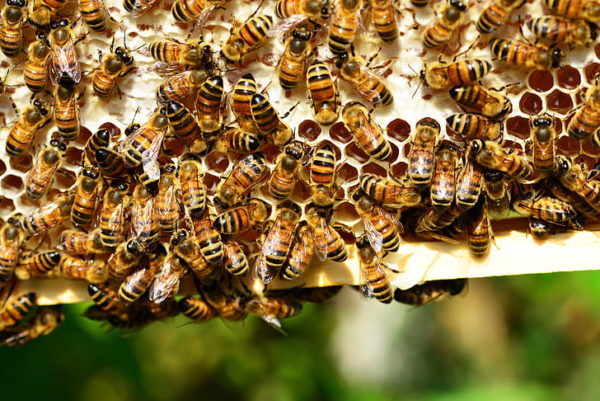A guest blog by Andrew Henckler, one of our Seven Stones’ Master Beekeepers
Summer is the peak season for honeybees. The hives are at their largest size of the year, up to 80,000 bees per hive. All of these bees are hard at work taking advantage of the bounty of the season. As each successive bloom of flowers in the area happens, the bees collect nectar and pollen from the plants. The season starts with dandelion flowers and other small, early bloomers, moves on to wild plum and crab apple blossoms, and then progresses through the sweet yellow clover, alfalfa, and all the beautiful flowering plants growing on the grounds of Seven Stones.

Once the bees bring the nectar back to the hive, they work hard to evaporate the nectar from its natural state of 80% water to around 16% water found in finished honey. That means they have to bring four times the amount of finished honey back to the hive in the form of nectar, plus enough to feed all the bees in the hive. Once the honey is finished, they seal it with a layer of wax to preserve it for the long term needs of the hive. This preserved honey is what the bees use to survive through the Winter.
Beekeepers make sure to give the bees optimal conditions so that there is extra honey for us to harvest, share, and enjoy.
This year Spring has sprung much earlier than last year. With warmer weather starting earlier, many plants started blooming sooner and the bees were able to start collecting large amounts of nectar sooner. An established hive in a good year may produce in excess of 50 pounds of honey in addition to what the bees need to keep for themselves. Most beekeepers harvest honey at the end of the Summer. Sometimes I harvest some honey midway through the season and collect the rest at the end of the Summer. Because the color and taste of the honey depend on the flowers that are blooming while the nectar is being collected, that way I usually get two different types of honey from the same hive.
Summer is, in many ways, the easiest time to “be a bee.” There is lots of food for the taking, the weather is always in the preferred temperature range of 50 degrees and above, and there are lots and lots of bees in every hive to share the work. The trade-off is that Summer bees generally only live about six (6) weeks compared to four (4) or more months for Winter bees. The queen is constantly laying eggs in the Spring and Summer both to build up the hive population and to replace the workers. The younger bees generally take care of the job of raising all the “new-bees” while the older, stronger bees do the work of gathering nectar and defending the hive.
Beekeepers are usually busy in the Spring and early Summer. We have to make sure that the hives are healthy and have enough food to make it to the time when lots of plants bloom. If hives have died over the Summer we usually split hives to turn one into two or buy a package of bees to re-establish the hive. We check to see if bees need to be treated for varroa mites or other pests. We also place “supers” on top of the hives. When the nectar is being brought into the hive, the bees will first refill their own long-term supplies. The supers are extra boxes on top of the hive where they can put excess honey. The location makes it easier for beekeepers to harvest the extra honey by simply lifting the full boxes off the hive and avoids disturbing the heart of the hive.

